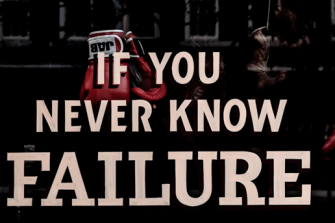Cease and desist
Question one: Have we passed our use-by date? Would the world miss our organisation if we were not here? Do we offer anything that could not be done equally well or better by someone else?
Several years ago, the President of a major sporting code suggested that every AGM should open with a winding up motion. If the gathering could not argue away from the proposition in a cogent manner, then perhaps it was indeed time to cease and desist. This is a particular form of structured discussion—and yes, he was a lawyer.
But the point is well made. Everyone, especially the board, should be able to articulate the organisation’s purpose and its unique contribution to the world.
We sometimes start strategic sessions with this useful question and sadly we often see people struggle as they try to frame answers that should be top of mind.
Commercial organisations who lose this focus quickly find the marketplace gets tough.[1] We know[2] that non-profit entities are subject to far less churn, but times are changing. In Aotearoa New Zealand we have over 28,000 charities falling over each other and eating unnecessary overhead resource. The Incorporated Society world is hardly better—24,000 of them. Time for some rationalisation.
Do we have a clear organisational purpose? Yes/No
Are we there yet?
Anyone who has ventured on holiday with a backseat of sullen offspring knows this one.
‘Are we there yet?’ suggests a known destination. What will the result of our activity look like in tangible terms? What is the nature of the change we are trying to make in the world?
It is extraordinarily difficult to construct strategy without an intended outcome. The time-worn acronym - SMART, works well: Specific, Measurable, Achievable, Realistic and Time-bound. Odd that this has been around for so long and yet!
It is easy to be busy. Everyone is busy and often resource-thin and time-poor. But effective? That’s a different question and one that cannot be answered without a projected end point.
A useful strategy thinking tool is back-casting. Start with the desired outcome and work backwards to understand what must be in place to get to that outcome. What are the pre-conditions for success?
It is a complex world. VUCA is the current acronym—volatility, uncertainty, complexity and ambiguity—sometimes floated as justification for having only a short-term strategy. This misses the point.
We agree that strategy needs to be constantly reviewed and mutable in an uncertain world and that process will led to new or varied strategy. Mintzberg[3] wrote about emergent strategy nearly forty years ago. But strategy review needs a frame, and that frame is intended outcomes.
Are we clear on our intended outcomes? Yes/No
The weka and the Cheshire cat
‘If you don’t know where you’re going, any road will get you there’ are not Lewis Carroll’s literal words but a common paraphrase of this exchange:
“Would you tell me, please, which way I ought to go from here?”
“That depends a good deal on where you want to get to,” said the Cat.
“I don’t much care where,” said Alice.
“Then it doesn’t matter which way you go,” said the Cat.
It follows that if the check boxes above are not ticked then indeed any road will do. We are fond of the True North concept as outlined in the seminal article[4] Mission Driven Governance. This suggests that the organisation is clear about its purpose and the direction of travel to get there—True North. Every resource allocation and decision is tested against True North. Is this the best possible application of time and money to keep the boat moving at the fastest speed possible in the desired direction? It forces consideration of options. John Carver’s excellent definition of governance[5] is “the creation of the right benefits for the right people at the right cost”. Only when all three elements have been considered can the board be sure it has given full scrutiny to the matter.
The opposite of mission-driven governance is something we call ‘weka governance’. Many of you will have experienced a weka or two heading off into the undergrowth with a shiny bit of your camping equipment. Too many organisations exhibit the same behaviour—heading off into new ventures without adequate scrutiny of alignment to purpose and strategy. In the non-profit world, this is especially evident, with funders driving strategy of organisations rather than the organisation having a sound strategy and looking for aligned funders.
What you end up with—as one wise director suggests—is a ‘bugger’s muddle’ of an organisation.
True North? Yes/No or Weka governance? Yes/No
Crowd-funded strategy
Let’s be clear. It is the board and only the board—as the owners’ representatives—who can determine the purpose of the organisation and the benefits to be generated through its activities. This cannot be delegated. So strategic thinking around the board table—making organisational intent clear—must occur before strategic planning can start.
The more people you ask[6] to guess the number of jellybeans in a giant jar, the greater the accuracy. But sadly, this technique does not directly translate to strategic thinking!
Consider the work of Ricardo Semler[7] and, more recently, the writing of Gary Hamel in Humanocracy.[8] Both outline collaborative approaches that embrace strategy to some degree. Certainly, they strongly make the case for pushing decisions down to those most affected by them. But before people are engaged in tactical discussion, the board must set the high-level thinking.
We have seen too many processes that start without boundaries, often with planning facilitators who can’t believe their luck, wafting around the country talking to all and sundry. The results? Often a long list of aspirations, grievance, pet projects, old ideas warmed through…and some very well-paid consultants.
Any consultation must be undertaken within a framework. Too many plans start without focus, work their way up the layers, through the design department and land on the board table with so much buy-in and emotional baggage it is hard to wind anything back.
Are we in thrall to strategy by the masses? Yes/No
Campfire marshmallows
We firmly believe in values underpinning policy. In the absence of a specific guidelines, people fall back on their values base for guidance. Equally, any organisation should discuss and make clear those things it holds dear. This can be helpful to chief executives. If in doubt on any matter, they can check for consistency with organisational values.
[There is] a growing and unfortunate tendency to equate Mom-and-apple-pie values, fluffy packages of buzzwords, motivational slogans, and financial goals with strategy.[9]
Richard Remult
But values are not strategy. All credit to organisations who spend the time together to explore and record their belief systems. We encourage that. But a series of values/beliefs should not be dressed up as strategic pillars. When pressed chief executives will admit values alone provide insufficient guidance if making major strategic choice.
A simple statement of values as part of governance policy, certainly. As the heart of a strategic plan? Probably not.
Is it all just a bit soft? Yes/No
Boiling the ocean
We are big fans of Roger Martin when it comes to thinking around strategy. The book Playing to Win,[10] written with Alan G Lafley, suggests that strategy has two central considerations: where to play (which market/s) and how to win (competitive advantage).
It is—or should be—obvious that you can’t be all things to all people all the time. Yet we often see organisations with modest resources tilting at windmills. You can only be accountable for the things you have direct control over and, to a lesser extent, can influence. This may be as a solo effort or in partnership with others. But most of the market is, for most organisations, simply beyond reach and likely to stay that way. A board can only assess the efficacy of a strategy if cause and effect are connected.
Organisations should still tell their top-level story. If the goal is reducing child poverty, then make the case as strongly as possible. But this challenge requires cross-government alignment, and multiple partnerships across possibly hundreds of organisations. The question then is: what can a single entity contribute? Simply put, how will we make a difference and how will we know?
Focus on what you control and can measure and be accountable for. Funders, stakeholders and the board all need a framework to judge strategic efficacy.
Are we trying to boil the ocean? Yes/No
We will be customer-centric
Strategy involves choice between two viable alternatives.
Strategy is the act of making a new set of choices designed to solve a problem that was created by the interaction of the existing set of choices with the competitive environment[11]
Roger Martin
All too often plastered on plans, phrases such as ‘customer-centric’, ‘deliver excellence’, ‘operate with integrity’ are simple nonsense. The opposites are not a valid choice: ‘ignore customers’, ‘shoddy is OK’, ‘ethics are flexible’. While too often in evidence, these are not real choices.
Premium positioning or competition on cost are real options; which markets or geographies are options. But sadly, much of word spaghetti on plans is simply fatuous.
Are we focused on false choices? Yes/No
Verbs, verbs, everywhere
Lead, embrace, enhance, facilitate, collaborate—and their evil counterparts: impactful, nimble, pivoting, responsiveness etc—should be banned at the top of any plan. They speak of actions not outcomes. We will take a leadership role – really? This is the half-Moses scenario. People, follow me for a jolly 40 days and nights in the desert. Not especially compelling if the land of milk and honey on the other side is not mentioned.
The board is primarily interested in the results of an organisation’s activities, not necessarily the detail. Vague statements such as ‘meaningful cross-sector collaboration to produce co-designed outcomes of mutual benefit’ deserve all the derision that should follow. To partner or not is a valid choice and may indeed be an area of strategic focus. But the benefits need to be clearer than a bag full of homilies.
Are there too many verbs? An emphasis on actions, not results? Yes/No
‘A wish list sprinkled with fairy dust’
This paraphrases one of our favourite strategic planning thinkers, Richard Remult.[12] He notes that any plan that does not address key challenges is akin to something sent to Santa.
There must one or several reasons why we have not achieved the desired outcomes outlined in our well-crafted plan. If not, we would already be there and wouldn’t need any further strategy—just business as usual.
Einstein is supposed to have said if he was given an hour to save the world, “I would spend 55 minutes defining the problem and then five minutes solving it”.
Only when the problem is identified can we know if a new set of choices has a plausible chance of solving the problem or not.[13]
Roger Martin
Getting to the genuine root cause of an issue takes time and often rigorous enquiry. Betting the shop on assumptions is not strategy. Research, analysis, hypothesis, testing, learning and—as necessary—switching tactics are all part of the process. But we need to know what the real problem is and what is causing it.
Is it a wish list unconnected to the challenges of the real world? Yes/No
Big hat, no cattle
The wonderful Randy Newman song nails it: Big hat, no cattle; Big snake, no rattle; Big boat, no paddle; Big belly, no heart.[14]
The plan is great, the coloured pencil department has done a bang-up job. Everyone was consulted, they all love it. We’ve nailed it and within five years everything will be coming up roses.
But how much resource have we transferred to the bright new direction? How many things will we stop doing? What different skills have we brought in? What have we let go? Are we searching for new partners? …and so on.
If the budget looks a lot like lasts year’s and the business plan is just fiddling around the edges, well…big hat, no cattle. We will not be awash with milk and honey in five years and all the people we took on the journey will be harder to enrol next time.
Is this all just ‘Big hat, no cattle’ without genuine change? Yes/No
A checklist
This may all sound a little harsh, but we have seen multiple examples of the above—sometimes many in one place. So, here is the list in a more sober form. We urge you to run your plans across this, in draft, before it’s too late:
- Do we have a clear organisational purpose?
- Are there succinct measurable outcomes?
- Is everything is aligned to our purpose (True North)?
- Has the board first done its work—setting intent?
- Are genuine choices are being made between valid options?
- Values are important but are they being dressed up as strategy?
- Are we disciplined and focused, not trying to be all things to all people?
- Is the plan led by verbs, being actions rather than their results?
- Have we analysed and made clear the challenges the strategy is intended to address?
- Have we aligned and committed serious resource to the plan?
[1] See https://www.innosight.com/insight/creative-destruction/
[2] Se JB Were Cause Report 2017. Page 5
[3] https://mintzberg.org/
[4] Fisman, R. R.Kurana and E Marteson. Mission Drive Governance. Stanford Social Innovation Review. Summer 2009
[5] https://www.carvergovernance.com/
[6] See https://www.bbc.com/future/article/20140708-when-crowd-wisdom-goes-wrong
[7] https://en.wikipedia.org/wiki/Ricardo_Semler
[8] https://www.humanocracy.com/ Our review will be published in a future Good Governance
[9] Taken from the publisher’s (Penguin Random House) synopsis of his book Good Strategy Bad Strategy 2011
[10] Playing to Win. How Strategy Really Works. A.G Lafley and Roger L. Martin. Harvard Business Review Press 2013
[11] https://rogermartin.medium.com/strategy-as-problem-solving-5c6fb9291d87
[12] http://goodbadstrategy.com/
[13] https://rogermartin.medium.com/strategy-as-problem-solving-5c6fb9291d87
[14] From Bad Love, released 1999








